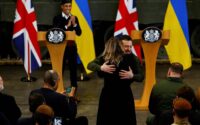Refugee returns to Ukraine to chronicle ‘the real side’ of war
Iryna Verbivska had already seen the worst of war.
She hid in an underground bunker last February with her 83-year-old grandmother, Reta, and her pitbull, Nigel, as Russian jets tore through Ukrainian skies during the war’s opening salvo.
She fled to Moldova hidden in a tank convoy, holding her breath and waiting for Russian missiles to come and end her life.
But when the 37-year-old entrepreneur from Cherkasy, Ukraine, made it to Germany last April, she was shocked to see a different war on German TV than the atrocity-filled maelstrom from which she’d escaped.
“People knew a war was going on — but they weren’t showing how terrible it is,” Verbivska said.
So she determined that she’d return to her bleeding homeland — in secret, on the weekends, whenever she could — to document the cold realities of Vladimir Putin’s war and show it to the world.

But the scenes she recorded alongside her travel companion, a journalist named Igor Zakharenko, were so breathtaking in their horror that German news wouldn’t publish them.
Rows of dead men with their faces caved in like rotting pumpkins.
Charred bodies on the pavement, their blackened arms twisted like burnt chicken wings as they tried to escape their torched cars.
Abandoned stands of strollers, luggage and stuffed animals were surrounded by bloody lakes that stained the bricks on which they sat.
“I want people to see the real side of war,” said the former travel agent and professional translator.

“I saw people without heads, tortured to death. Just civilians, not soldiers. Heads smashed. Bodies piled up together, people burned … those pictures matter.”
It was so much different before the war.
Verbivska was a self-made woman, an entrepreneur who knew how to make a buck.
She owned a travel agency with offices in three cities and ran a translation office with 44 employees, she said.
She and her family also had a resort in Crimea, a vacation hotspot that offered tourists the chance to scuba dive and hop on local excursions.

That all changed when the Russians came.
They seized everything, Verbivska said.
She still remembers when she heard the first air raid warnings on Feb. 24, 2022, at about 6 p.m.
They hid in a milk factory bunker in Cherkasy before fleeing the city for her grandmother’s village in Synyavka, about three hours west of Kyiv.
“It was panic — kids crying, people running,” she recalled.

“One bunker didn’t allow dogs and said my dog had to stay outside — but my dog is like family. We were looking for another bunker and didn’t know what to expect.”
“We spent the whole night in a bunker with cats, dogs, and people. We were sitting there underground and didn’t know what was happening above us.
“People thought that Ukraine didn’t exist anymore.”
It was a rude awakening for Verbivska, who thought the war would be over in two days.
And it was a nightmare come alive for her grandmother, who survived World War II’s savagery.
“She knows what war is,” Verbivska said.

“I didn’t know.”
They heard the jets overhead — they don’t know if they were Russian or Ukrainian — and the explosions decimating Kyiv, Ukraine’s capital city.
They were also running out of water.
It was time to go.
“We didn’t feel safe,” Verbivska said.

When she fled for Moldova with her mother, grandmother, dog and two cats in March 2022, they had little more than each other and a few small bags.
The family hid their car among a row of tanks, waiting for Russian airstrikes.
“We feared the Russians knew about the tank line,” she said.
“It was the longest drive of my life. My mother and grandmother were crying, and I tried to not show my fear.
“But inside, I had so much fear. I was smiling and telling jokes on the outside, but I was even more scared than them. I was shaking while driving.”
But the missiles never came.

The family crossed into Moldova, and arrived in Germany by April.
They’ve been there ever since.
Verbivska was safe at last, but she couldn’t stand still.
Frustrated by what she thought was the sanitized international coverage of the war, she decided to head back to her mutilated nation.

Why?
Because there was an ugly truth that needed to be told.
So under the guise of going to Berlin for business, she snuck back across the border time and time again to chronicle Ukraine’s bloodiest hour.
The scenes that greeted her were heart-stopping.
They found scorched bodies piled on the highways and corpses of naked women, surrounded by condoms, who she believed had been raped before they were butchered.

In Bucha, she and Zakharenko stumbled upon killing fields rarely found in Europe since 1945.
“There were so many bodies on the streets — dead animals, women, children,” Verbivska said.
“We would visit houses and see people shot dead in their beds. They went to animal shelters and killed dogs. How are you protecting yourself when you’re killing dogs?
“We saw the body of a man on a fallen bicycle, shot dead. These weren’t soldiers. They were civilians trying to escape.”
In the shattered port city of Mariupol, the pair played possum by hiding in a field of corpses as Russian fighters flew overhead.
“We were laying on dead bodies,” she said.

“I was thinking I would die right now, and my mother wouldn’t know where I was. She thought I was in Berlin.”
Twice they were caught in a vicious crossfire that threatened to cut short their lives.
Both times, she worried that her family wouldn’t know where to find her body.
She stopped the visits last fall after a close call in Irpin left her somewhat shell-shocked.
“There was a lot of shooting — this was the moment when I thought I would really die,” Verbivska said.
Now she lives a decent — if comparatively quiet — life in Germany.
She works for the mayor’s office in Kornwestheim, and joined the Rotary Club.
She plans to go back to Ukraine when the war ends, even though all her businesses are smoke and ash.
But still, her eyes blaze when she talks about the Russian foe, who tortured and burned his way across the Ukrainian plains.
“People shouldn’t say they hate people. But I can’t help it,” she said.
“I hate all Russians now. Even when [Russian] people say they stand for Ukraine, I can’t help myself. I hate them.”
“I know there are many good Russians, and I have friends in Russia,” she continued.
“But I don’t speak to them anymore. After what I saw … this is the feeling I now have.”


